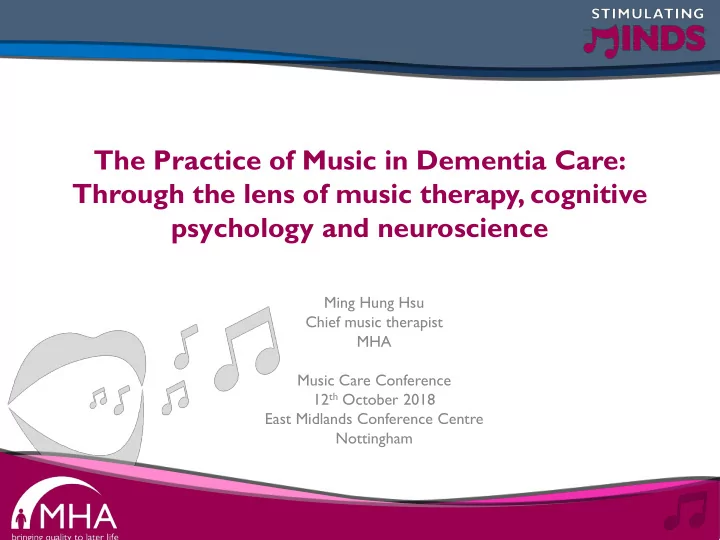

The Practice of Music in Dementia Care: Through the lens of music therapy, cognitive psychology and neuroscience Ming Hung Hsu Chief music therapist MHA Music Care Conference 12 th October 2018 East Midlands Conference Centre Nottingham
The role of MHA music therapists in dementia care Supporting carers in managing symptoms of dementia such as agitation, apathy, anxiety, depression, etc.
Assessing cognitive functions • Selective attention Ability to focus on certain visual (piano) or auditory (sounds/music) objects • Semantic memory Understand the meaning of ‘piano’ as a word and an instrument • Autobiographical memory Recall meaningful, significant personal life events e.g. learning to play the piano
Protocol for de-escalating agitation • Prevent out-of-breath episodes • Avoid direct eye contact • Auditory cue- conversation using the key word ‘piano’
Support and work alongside staff Revolta, Orrell and Spector, 2017; Rapaport et al., 2018: Psychosocial interventions should support and enable staff to interact with • individual residents and to analyse the underlying reasons for agitation, which may include pain, discomfort, loneliness and boredom. • Using personalised interventions to reduce agitation and increase quality of life of their residents Spector, A., Revolta, C., & Orrell, M. (2016). The impact of staff training on staff outcomes in dementia care: a systematic review. International journal of geriatric psychiatry , 31 (11), 1172-1187. Rapaport, P., Livingston, G., Hamilton, O., Turner, R., Stringer, A., Robertson, S., & Cooper, C. (2018). How do care home staff understand, manage and respond to agitation in people with dementia? A qualitative study. BMJ open , 8 (6), e022260 .
Music
Why emotion regulation? • Managing neuropsychiatric symptoms of dementia such as agitation, depression, anxiety and apathy is a major challenge in dementia care (Lawlor, 2002) • Care home residents‘ quality of life is greatly impacted by their mood in terms of depression, anxiety and agitation (Hoe et al. 2006; Beerens et al., 2013) • Interventions for improving emotion regulation lead to physical and psychosocial improvement for patients with medical or psychiatric illness (Smyth and Arigo, 2009)
Process model of emotion regulation (Gross, 1998)
Etkin, Büchel & Gross (2015). The neural bases of emotion regulation. Nature Reviews Neuroscience, 16(11), 693.
Process model of emotion regulation (Gross, 1998)
Music therapists dissect elements of music Building blocks of music • Rhythm • Melody • Harmony • Timbre • Form • T exture • Dynamics
Attentional deployment using melodic patterns
Attentional deployment Müllensiefen & Halpern, 2014, Music Perception: An Interdisciplinary Journal Melodic chunking • A strong common factor is the uniqueness of short melodic motives . • Note duration and melodic contour Shorter note durations and more variable pitch contours seem to predict better implicit memory
Response modulation
Response modulation: beat and dynamics
Inverted U theory (Yerkes & Dodson, 1908)
Response modulation: reduced tempo/texture and an emphasis on melody/timbre
Response modulation • Hailstone et al. (2009). It's not what you play, it's how you play it: Timbre affects perception of emotion in music. The Quarterly Journal of Experimental Psychology , 62 (11), 2141-2155 • Bogert et al. (2016). Hidden sources of joy, fear, and sadness: Explicit versus implicit neural processing of musical emotions . Neuropsychologia , 89 , 393-402.
Caveats
Short-term & adverse effect Mozart effect (Arousal-and-mood hypothesis- temporary • indirect effect of emotion reactions) (Thompson et al., 2001; Husain et al., 2002; Schellenberg et al., 2007; He, Wong & Hui, 2017) Maladaptive emotion regulation through music ( Carlson, • Saarikallio et al., 2015 Frontiers in Human Neuroscience ; Hou, Song et al., 2017)
Recommend
More recommend